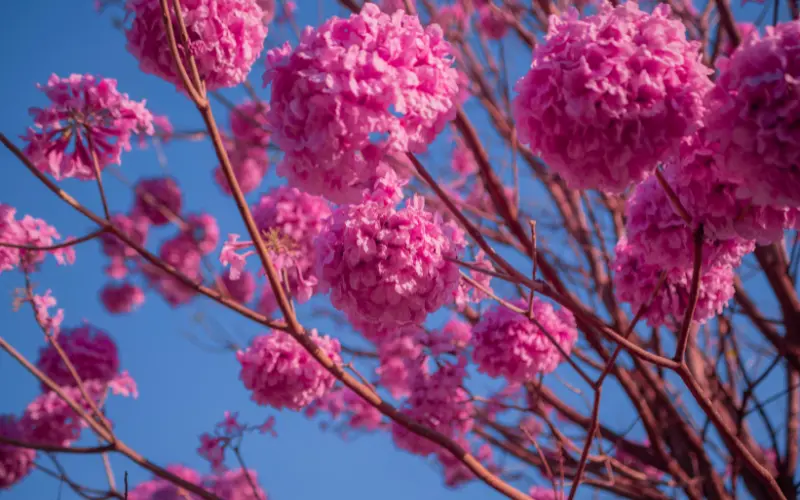The Tabebuya tree has recently gained popularity and is now widely planted in major cities across Indonesia.
This is not without reason—Tabebuya’s appealing shape and vibrant colors have captured the hearts of many.
In fact, Tabebuya flowers are often used as decorative plants to replace cherry blossoms due to their similar appearance.
Thinking of planting a Tabebuya tree at home? Let’s explore its origins, blooming season, and varieties.
Getting to Know Tabebuya Flowers
Tabebuya plants are originally from the Americas but can also be found in Mexico and Brazil.
Etymologically, the name “Tabebuya” comes from the Tupi language in Brazil, where “tacyba bebuya” means “ant tree.” This name emerged because ants often use Tabebuya trees as their nesting grounds.
The Tabebuya flower boasts over 100 species, and its most distinctive feature is its vibrant, colorful petals. In recent years, this tree has become a favorite for decorating yards and even city sidewalks.
When Does the Tabebuya Bloom?
Tabebuya trees bloom seasonally. According to Hadi Susilo Arifin, Head of the Master Program in Natural Resource and Environmental Management at IPB University, Tabebuya flowers typically bloom during the dry season.
During the rainy season, Tabebuya trees are unlikely to flower. Instead, in the sunnier months like July-August or September-October, they bloom abundantly, displaying stunning beauty.
Although Tabebuya trees are widely found in Indonesia, not all areas are suitable for cultivating them.
Benefits of the Tabebuya Tree
Tabebuya trees offer various benefits—not only for the environment but also for health. Here are a few highlights:
Can Be Used as Fertilizer
Surprisingly, Tabebuya flowers can be processed into fertilizer.
If you have Tabebuya trees at home, you can turn parts of the plant into organic fertilizer. Simply collect the fallen flowers, let them decompose, and spread them over your desired area.
Helps Reduce Fever
According to A Synopsis of Bignoniaceae Ethnobotany and Economic Botany by Gentry, tea made from Tabebuya flowers may help alleviate fever.
However, further research is needed to confirm this claim. Would you be interested in trying it?
Helping in Weight Loss and Pancreas Treatment
Purple Tabebuya flowers are known to help reduce obesity due to their high antioxidant content, as reported in the Journal of Functional Foods in 2021.
Additionally, Tabebuya flowers are believed to aid in treating pancreatic diseases. The use of Tabebuya as traditional medicine dates back to the Inca civilization.
Types of Tabebuya Flowers to Beautify Your Yard
After learning about Tabebuya’s background and benefits, here are a few varieties you can choose from:
Pink Tabebuya
Pink Tabebuya is the most common variety, often used as a shade tree.
At first glance, it resembles cherry blossoms. When in full bloom, pink Tabebuya flowers are strikingly beautiful, earning them the nickname “Indonesia’s cherry blossoms.”
Yellow Tabebuya
Another popular variety is the yellow Tabebuya, known for its bright, eye-catching color.
Planting yellow Tabebuya in your yard can make your home look brighter and more charming. Its vibrant hue pairs well with minimalist modern buildings, especially those with dominant white tones.
Magenta Tabebuya
Prefer darker shades? Don’t worry—Tabebuya flowers also come in purple or magenta.
These purple tones range from deep lavender to hints of red or blue.
Unlike brighter varieties, purple Tabebuya flowers provide a more subdued and calming ambiance.
This overview of Tabebuya trees, from their origins and blooming seasons to their benefits and types, offers a glimpse into their beauty and versatility. Hopefully, this information inspires you!




